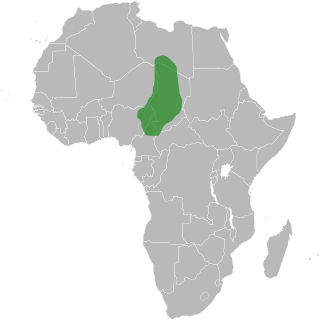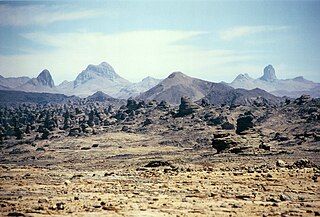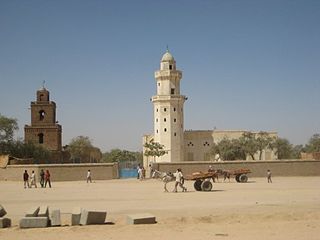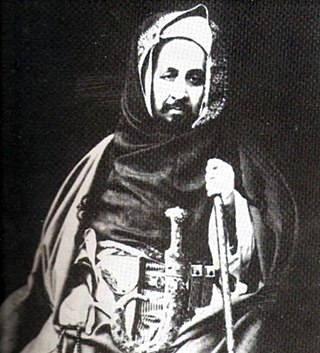Related Research Articles

The Kanem–Bornu Empire existed in areas which are now part of Nigeria, Niger, Cameroon, Libya and Chad. It was known to the Arabian geographers as the Kanem Empire from the 8th century AD onward and lasted as the independent kingdom of Bornu until 1900.

The Senusiyya, Senussi or Sanusi are a Muslim political-religious Sufi order and clan in colonial Libya and the Sudan region founded in Mecca in 1837 by the Grand Sanussi, the Algerian Muhammad ibn Ali al-Sanusi. Sanusi was concerned with what he saw as both the decline of Islamic thought and spirituality and the weakening of Muslim political integrity.

Muhammad Idris bin Muhammad al-Mahdi as-Senussi was a Libyan political and religious leader who was King of Libya from 24 December 1951 until his overthrow on 1 September 1969. He ruled over the United Kingdom of Libya from 1951 to 1963, after which the country became known as simply the Kingdom of Libya. Idris had served as Emir of Cyrenaica and Tripolitania from the 1920s until 1951. He was the chief of the Senussi Muslim order.

Fezzan is the southwestern region of modern Libya. It is largely desert, but broken by mountains, uplands, and dry river valleys (wadis) in the north, where oases enable ancient towns and villages to survive deep in the otherwise inhospitable Sahara Desert. The term originally applied to the land beyond the coastal strip of Africa proconsularis, including the Nafusa and extending west of modern Libya over Ouargla and Illizi. As these Berber areas came to be associated with the regions of Tripoli, Cirta or Algiers, the name was increasingly applied to the arid areas south of Tripolitania.

The Tibesti Mountains are a mountain range in the central Sahara, primarily located in the extreme north of Chad, with a small portion located in southern Libya. The highest peak in the range, Emi Koussi, lies to the south at a height of 3,415 meters (11,204 ft) and is the highest point in both Chad and the Sahara. Bikku Bitti, the highest peak in Libya, is located in the north of the range. The central third of the Tibesti is of volcanic origin and consists of five volcanoes topped by large depressions: Emi Koussi, Tarso Toon, Tarso Voon, Tarso Yega and Toussidé. Major lava flows have formed vast plateaus that overlie Paleozoic sandstone. The volcanic activity was the result of a continental hotspot that arose during the Oligocene and continued in some places until the Holocene, creating fumaroles, hot springs, mud pools and deposits of natron and sulfur. Erosion has shaped volcanic spires and carved an extensive network of canyons through which run rivers subject to highly irregular flows that are rapidly lost to the desert sands.

The earliest presence of Islam in Chad can be traced back to Uqba ibn Nafi, whose descendants can be found settled in the Lake Chad region to this day. By the time Arab migrants began arriving from the east in the fourteenth century in sizeable numbers, the creed was already well established. Islamization in Chad was gradual, the effect of the slow spread of Islamic civilization beyond its political frontiers. Among Chadian Muslims, 48% professed to be Sunni, 21% Shia, 23% just Muslim and 4% Other.

Most Libyans adhere to the Sunni branch of Islam, which provides both a spiritual guide for individuals and a keystone for government policy. Its tenets stress a unity of religion and state rather than a separation or distinction between the two, and even those Muslims who have ceased to believe fully in Islam retain Islamic habits and attitudes. The post-revolution National Transitional Council has explicitly endeavored to reaffirm Islamic values, enhance appreciation of Islamic culture, elevate the status of Qur'anic law and, to a considerable degree, emphasize Qur'anic practice in everyday Libyan life with legal implementation in accordance to Islamic jurisprudence known as sharia. Libya has a very small presence of Ahmadis and Shias consisting of Pakistani immigrants, though unrecognized by the state.

Daza is a Nilo-Saharan language spoken by the Daza people inhabiting northern Chad. The Daza are also known as the Gouran (Gorane) in Chad. Dazaga is spoken by around 380,000 people, primarily in the Djurab Desert region and the Borkou region, locally called Haya or Faya-Largeau northern-central Chad, the capital of the Dazaga people. Dazaga is spoken in the Tibesti Mountains of Chad, in eastern Niger near N'guigmi and to the north. It is also spoken to a smaller extent in Libya and in Sudan, where there is a community of 3,000 speakers in the city of Omdurman. There's also a small diaspora community working in Jeddah, Saudi Arabia.

Murzuk, Murzuq, Murzug or Merzug is an oasis town and the capital of the Murzuq District in the Fezzan region of southwest Libya. It lies on the northern edge of the Murzuq Desert, an extremely arid region of ergs or great sand dunes which is part of the greater Sahara Desert.

The Toubou or Tubu are an ethnic group native to the Tibesti Mountains that inhabit the central Sahara in northern Chad, southern Libya and northeastern Niger. They live either as herders and nomads or as farmers near oases. Their society is clan-based, with each clan having certain oases, pastures and wells.

FROLINAT was an insurgent rebel group active in Chad between 1966 and 1993.

The coastal region of what is today Libya was ruled by the Ottoman Empire from 1551 to 1912. First, from 1551 to 1864, as the Eyalet of Tripolitania or Bey and Subjects of Tripoli of Barbary, later, from 1864 to 1912, as the Vilayet of Tripolitania. It was also known as the Kingdom of Tripoli, even though it was not technically a kingdom, but an Ottoman province ruled by pashas (governors). The Karamanli dynasty ruled the province as a de facto hereditary monarchy from 1711 to 1835, despite remaining under nominal Ottoman rule and suzerainty from Constantinople.

Oueddei Kichidemi was the father of the former Chadian President Goukouni Oueddei and was the tribal leader, or derde, of the Toubou Teda of the Tibesti during the First Chadian Civil War.
Zouar is a town in the Tibesti Ouest department of the Tibesti region in northern Chad, located in an oasis in the Tibesti Mountains. Prior to 2008 it was in the Tibesti Department of the former Bourkou-Ennedi-Tibesti region

Kaocen Ag Geda (1880–1919) was a Tuareg noble and clan leader. Born in 1880 near wadi Tamazlaght Aïr, Kaocen from tribe of Ikazkazan berber, a subset of the Kel Owey confederation. He led the Kaocen revolt, a rebellion against French colonial rule of the area around the Aïr Mountains of northern Niger, during 1916–17. After the defeat of the revolt, Kaocen fled north; he was captured and hanged in 1919 by local forces in Mourzouk, Libya.

Conflicts took place in North Africa during World War I (1914–1918) between the Central Powers and the Entente and its allies. The Senussi of Libya sided with the Ottoman Empire and the German Empire against the British Empire and the Kingdom of Italy. On 14 November 1914, the Ottoman Sultan proclaimed a jihad and sought to create a diversion to draw British troops from the Sinai and Palestine Campaign. Italy wished to preserve its gains from the Italo-Turkish War. The Senussi Campaign took place in North Africa from 23 November 1915 to February 1917.

The Chadian Civil War of 1965–1979 was waged by several rebel factions against two Chadian governments. The initial rebellion erupted in opposition to Chadian President François Tombalbaye, whose regime was marked by authoritarianism, extreme corruption, and favoritism. In 1975 Tombalbaye was murdered by his own army, and a military government headed by Félix Malloum emerged and continued the war against the insurgents. Following foreign interventions by Libya and France, the fracturing of the rebels into rival factions, and an escalation of the fighting, Malloum stepped down in March 1979. This paved the way for a new national government, known as "Transitional Government of National Unity" (GUNT).

Ahmed Sharif as-Senussi was the supreme leader of the Senussi order (1902–1933), although his leadership in the years 1917–1933 could be considered nominal. His daughter, Fatimah el-Sharif was the Queen consort of King Idris I of Libya.

Tibesti Region is a region of Chad, located in far northwest of the country. Its capital is Bardaï. It was created in 2008 when the former Borkou-Ennedi-Tibesti Region was split into three, with the Tibesti Department becoming the Tibesti Region. The region is named for the Tibesti Mountains, one of the most prominent mountain chains in the Sahara Desert. Tibesti is the least populated region of Chad, and also has the lowest GDP in the country.

In late January 2019, the Libyan National Army (LNA) led by Marshal Khalifa Haftar launched an offensive to take control of the city of Sabha and the rest of southern Libya from the internationally recognised Government of National Accord (GNA) and local factions. Officially, the LNA announced that the reason for the operation was to remove terrorists, Chadian rebel groups, and to secure the border, but it has expanded Haftar's territorial control and acquired him oil fields near Sabha. It has also restarted some interethnic conflicts as the LNA has allied with local Arab tribes, while the Tuareg and Toubou tribal militias are loyal to the GNA.
References
- "A Country Study: Chad". Library of Congress Country Studies. 1990.
- J. Brachet & J. Scheele (2015). "Fleeting Glory in a Wasteland: Wealth, Politics, and Autonomy in Northern Chad". Comparative Studies in Society and History, 57(3), 723-752. doi:10.1017/S0010417515000262
- A. Zaborski, "Tubu" in Encyclopaedia of Islam